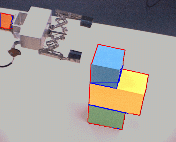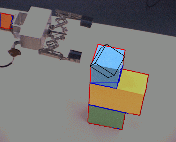 An example of
model based object recognition
An example of
model based object recognition
The following film shows how an object is identified using a
model stored in the JANUS model database. The method is similar to
the one described in A model based
approach to recognition and measurement of partially hidden objects in
complex scenes.
 In the first phase, the contours of the interesting objects are
detected. This is done by a grid search over the picture. Afterwards
a flood fill method is applied to get contours of the objects.
In the first phase, the contours of the interesting objects are
detected. This is done by a grid search over the picture. Afterwards
a flood fill method is applied to get contours of the objects.
 In the next phase, a model based fitting is applied to to selected
objects parameters (distance, orientation, ...).
In the next phase, a model based fitting is applied to to selected
objects parameters (distance, orientation, ...).
 As a result of this, one gets classification and a scale model
of the object, this includes position and orientation in the camera
coordinate system.
As a result of this, one gets classification and a scale model
of the object, this includes position and orientation in the camera
coordinate system.
 To enable the observation everything is much slower than in reality.
The methods described in
A model based approach to recognition
and measurement of partially hidden objects in complex scenes
have been
further improved, so that we achieve 1-3 seconds on a single
PC out of our PC cluster. This
time is still quite long, but there is a rich set of promising
heuristics,
which we have not yet included into the speed up process.
Once a good first hypothesis has been found, the fine iteration is very
fast (0.05 sec). In the video this results in a very fast fitting at
the
end of the iteration. Therefore tracking of an already recognized but
moving object should be possible in real time.
To enable the observation everything is much slower than in reality.
The methods described in
A model based approach to recognition
and measurement of partially hidden objects in complex scenes
have been
further improved, so that we achieve 1-3 seconds on a single
PC out of our PC cluster. This
time is still quite long, but there is a rich set of promising
heuristics,
which we have not yet included into the speed up process.
Once a good first hypothesis has been found, the fine iteration is very
fast (0.05 sec). In the video this results in a very fast fitting at
the
end of the iteration. Therefore tracking of an already recognized but
moving object should be possible in real time.
 In the first phase, the contours of the interesting objects are
detected. This is done by a grid search over the picture. Afterwards
a flood fill method is applied to get contours of the objects.
In the first phase, the contours of the interesting objects are
detected. This is done by a grid search over the picture. Afterwards
a flood fill method is applied to get contours of the objects.
 In the next phase, a model based fitting is applied to to selected
objects parameters (distance, orientation, ...).
In the next phase, a model based fitting is applied to to selected
objects parameters (distance, orientation, ...).
 An example of
model based object recognition
An example of
model based object recognition
 As a result of this, one gets classification and a scale model
of the object, this includes position and orientation in the camera
coordinate system.
As a result of this, one gets classification and a scale model
of the object, this includes position and orientation in the camera
coordinate system.
